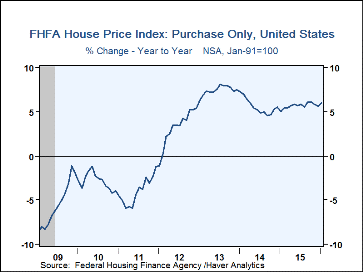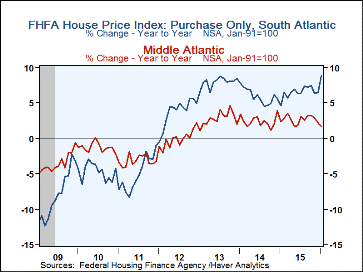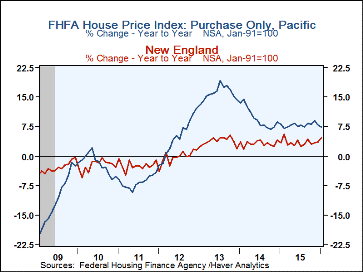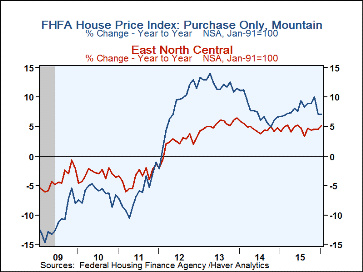 Global| Mar 22 2016
Global| Mar 22 2016U.S. FHFA Home Price Index Increases Steadily
by:Tom Moeller
|in:Economy in Brief
Summary
The U.S. House Price Index from the Federal Housing Finance Agency (FHFA) during January increased 0.5% for the third consecutive month. The annual rate of increase has been fairly steady near 6.0% since 2014. Prices were strongest in [...]
The U.S. House Price Index from the Federal Housing Finance Agency (FHFA) during January increased 0.5% for the third consecutive month. The annual rate of increase has been fairly steady near 6.0% since 2014.
Prices were strongest in the South Atlantic region where they rose 8.9% y/y, and accelerated to an 11.6% annual rate of growth during the last three months. In the Pacific region, prices 7.3% y/y and at an 8.2% annual rate in the last three months. The rise was followed by a 7.1% y/y increase in the Mountain states, but the rate cooled to 4.2% recently.
Prices rose 6.3% y/y in the West North Central region and have accelerated to 8.4% since October. Prices in the West South Central region gained 5.2% y/y, but the rate of increase slowed to 2.1% recently. In the East North Central region, house prices rose 5.1% y/y, and at 5.5% in the last three months.
Home prices rose roughly 4.5% y/y in the New England and East South Central regions, but the pace nearly doubled in both recently. In the Middle Atlantic states, house prices rose 1.7% y/y, but declined at a 2.1% rate in the last three months.
The FHFA house price index is a weighted repeat sales index. It measures average price changes in repeat sales of the same property. An associated quarterly index also includes refinancings on the same kinds of properties. The indexes are based on transactions involving conforming, conventional mortgages purchased or securitized by Fannie Mae or Freddie Mac. Only mortgage transactions on single-family properties are included. The FHFA data are available in Haver's USECON database.
| FHFA U.S. House Price Index, Purchase Only (SA %) | Jan | Dec | Nov | Jan Y/Y | 2015 | 2014 | 2013 |
|---|---|---|---|---|---|---|---|
| Total | 0.5 | 0.5 | 0.5 | 6.0 | 5.7 | 5.6 | 7.5 |
| South Atlantic | 1.7 | 0.7 | 0.3 | 8.9 | 6.5 | 6.0 | 8.1 |
| Pacific | 0.0 | 0.4 | 1.6 | 7.3 | 7.9 | 9.6 | 16.1 |
| Mountain | 0.8 | -1.6 | 1.8 | 7.1 | 8.0 | 7.5 | 12.3 |
| West North Central | 1.2 | 0.4 | 0.5 | 6.3 | 4.4 | 4.1 | 4.9 |
| West South Central | 0.3 | 0.1 | 0.0 | 5.2 | 6.5 | 5.8 | 6.2 |
| East North Central | 0.4 | 0.8 | 0.1 | 5.1 | 4.6 | 4.7 | 5.4 |
| New England | 0.8 | 1.1 | 0.1 | 4.7 | 3.5 | 3.2 | 3.9 |
| East South Central | 0.1 | 1.5 | 0.4 | 4.6 | 4.9 | 3.6 | 4.2 |
| Middle Atlantic | -1.0 | 0.4 | 0.1 | 1.7 | 2.4 | 2.4 | 2.8 |
|
|
Tom Moeller
AuthorMore in Author Profile »Prior to joining Haver Analytics in 2000, Mr. Moeller worked as the Economist at Chancellor Capital Management from 1985 to 1999. There, he developed comprehensive economic forecasts and interpreted economic data for equity and fixed income portfolio managers. Also at Chancellor, Mr. Moeller worked as an equity analyst and was responsible for researching and rating companies in the economically sensitive automobile and housing industries for investment in Chancellor’s equity portfolio. Prior to joining Chancellor, Mr. Moeller was an Economist at Citibank from 1979 to 1984. He also analyzed pricing behavior in the metals industry for the Council on Wage and Price Stability in Washington, D.C. In 1999, Mr. Moeller received the award for most accurate forecast from the Forecasters' Club of New York. From 1990 to 1992 he was President of the New York Association for Business Economists. Mr. Moeller earned an M.B.A. in Finance from Fordham University, where he graduated in 1987. He holds a Bachelor of Arts in Economics from George Washington University.










